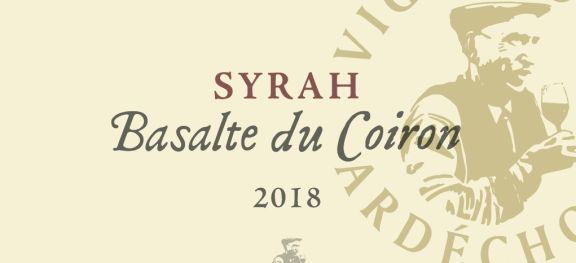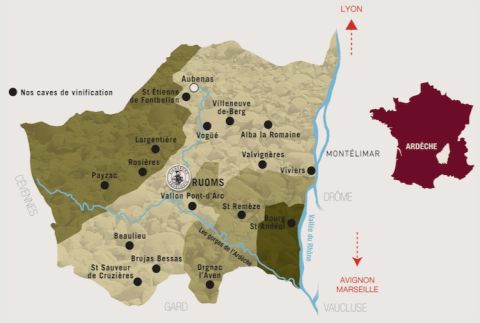Vignerons Ardéchois, Basalte du Coiron Syrah 2018

A great-value Syrah from south-eastern France that combines irresistible fragrance with generous amounts of peppery red and black fruit flavours.
From €7.90, £11.95, $12.99
I’ve been waiting for this wine, ever since I tasted the 2018 at Vinora, the first-ever international volcanic wine fair held in at the Vulcania theme park in Clermont-Ferrand at the end of January – coincidentally shortly after Richard proclaimed 2020 his year of Syrah. Here’s my enthusiastic tasting note on this deep-crimson wine:
This is so pretty, the floral side of Syrah and just a touch peppery. Juicy on the palate. Lightish, fresh, bone dry and yet so pretty on the finish. Such a joyful wine. I love it! It has the floral side of Syrah and the dry finesse of a stony site.
I gave it a score of 16.5 and suggested it would be drinking well for at least the next couple of years. The alcohol is a balanced 14%. When I tasted it again a couple of weeks ago, thanks to a sample sent by the wine’s UK importer Yapp Bros of Mere in Wiltshire, I loved its scent just as much but, giving it more time and attention because I was tasting it at home over a couple of days, I became more aware of its complexity and depth – surprising in an inexpensive wine. My second note was more expansive:
Fabulous aroma even when the wine is quite cool: pure, peppery Syrah that gives the impression it is from a cool climate though I don't think the Ardèche could be described as that. The fruit is more red-fruited than black but there's also a savoury taste of smoked bacon. Fragrant and scented but also has plenty of depth and length. More northern Rhône than southern in its floral delicacy but with the generosity, without excess weight, of a more southerly site. As the name suggests, this is volcanic soil and I do believe this has determined the very fine, dry texture of the tannins. Refined and still full of both flavour and scent on the palate. This may well age longer [I suggested up to 2023] but I find it irresistible now.
It seems that in the US, the 2016 is the current vintage (labelled simply Basalte Syrah). I made sure to taste it and found it to be just as scented and refreshing but perhaps a little more delicate, the fruit a little less generous, but still finely balanced and still so youthful, with the stony/mineral side more to the fore. It was slightly more versatile at the table than the 2018, which you could happily drink with or without food. Pierre Truyoo of Tru Wines in California told me that he has the 2018 on order and expects to have it in September.
It's always such a pleasure to find a wine of this quality at such a great price, especially one produced at a big co-operative. And the Vignerons Ardéchois is big: established in 1967 and comprising 12 wineries (marked on the map below, taken from their website) supplied by a thousand growers tending 6,000 ha (1,4825 acres) of vines in the southern Ardèche. They supply the fruit for Louis Latour's Ardèche Chardonnay, apparently.
Of the total vineyard area belonging to the members of the co-op, 300 ha are planted in the basalt soils between the villages of St-Jean le Centenier and Aubignas, just north of where this wine is made in Alba La Romaine, that resulted from the volcanic eruption 6 or 7 million years ago that created the Coiron plateau, a table mountain at 1,019 m (3,343 ft).
The Basalte du Coiron Syrah is part of the co-op’s Terroir range, for which winemaker Marion Bosquet (below) is responsible, working with consultant Valérie Lavigne, our oenology consultant, with the late Denis Dubourdieu, on the current ediiton of The Oxford Companion to Wine. Bosquet was born and raised in Sancerre, studied oenology in Montpellier and has worked in the northern Rhône (Paul Jaboulet Aîné), the Hunter Valley (Brokenwood), the Loire (Serge Dageneau et Filles) and the southern Rhône (Ch Les Amoureuses). She fell in love with an Ardèche winegrower and 2020 will be her sixth vintage here.
According to the growers, at night the basalt reflects back heat to these 40-year-old vines ensuring excellent ripening, especially with the relatively low yields of 35–39 hl/ha, although it was the combination of freshness and depth that appealed to me.
The grapes were harvested in mid September and fermented in stainless-steel tanks. The wine then spends a further 20 days on the skins to extract the tannins. Post-malolactic conversion, the wine spends six months in tank with a little bit of micro-oxygenation, which is presumably responsible for the smoothness of those tannins, and has the effect of stabilising the colour. I found the wine equally good on the day after opening and enjoyed it both very slightly chilled and at room temperature.
This lovely postcard from 1920, sent to me by export director Valentin Pellegrinelli, shows the south-west face of the Coiron mountains, where the foothills are today mainly planted with cereals. The co-op’s growers do farm a few hundred hectares here but the vines are mainly on the south-east facing slopes, shown above in the Syrah vineyard responsible for this wine. Vines have been here for centuries.
In the UK the 2018 is available from Yapp Brothers for just £11.95, which I consider to be very, very good value.
The wine is imported into the US by Pierre Truyoo of Tru Wines in California and available from JP Wines Direct, who are currently selling the 2016 for $12.99 though the price varies from that to around $16.99. It is also regularly listed at the following locations in California: The French Corner Café in Palm Desert (couldn’t resist adding the link – do take a look/listen even if you don’t live nearby), Topline in Glendale, Canyon Country Store in LA, Centro Basco Restaurant in Chino, Café Beaujolais in Eagle Rock, and Topanga Creek General Store.
The 2018 is also available in Germany. The 2017, which I haven’t tasted, is available in Denmark at 79 kroner.
Become a member to view this article and thousands more!
- 15,407 featured articles
- 274,946 wine reviews
- Maps from The World Atlas of Wine, 8th edition (RRP £50)
- The Oxford Companion to Wine, 5th edition (RRP £50)
- Members’ forum
- 15,407 featured articles
- 274,946 wine reviews
- Maps from The World Atlas of Wine, 8th edition (RRP £50)
- The Oxford Companion to Wine, 5th edition (RRP £50)
- Members’ forum
- 48-hour preview of all scheduled articles
- Commercial use of our wine reviews






